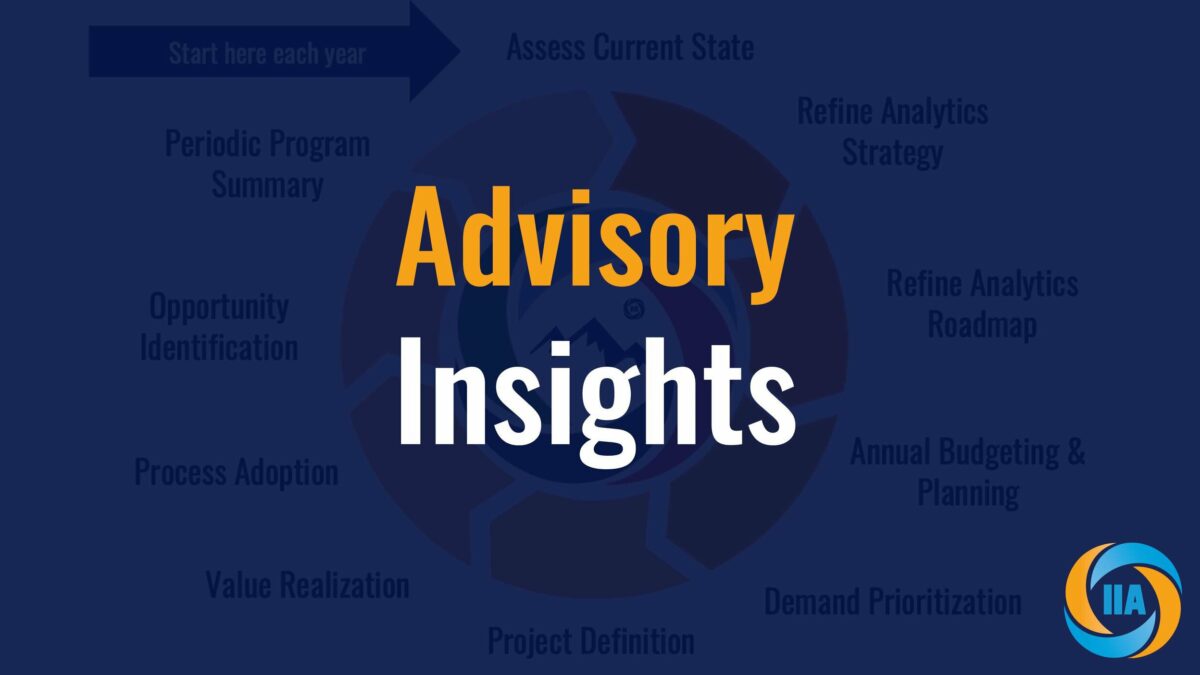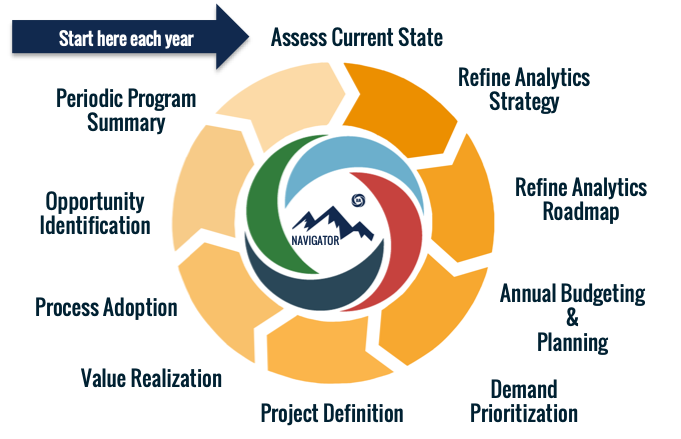
Organizations today are navigating the long and difficult journey of becoming truly data and analytics-driven. As an analytics-oriented professional undertaking your own journey, you’re focused on building stronger teams, more confident leadership and having a bigger impact on organizational decisions. In the process of pursuing those goals, you’ll need to navigate a variety of issues and activities. By putting a logical structure around the challenges you’ll face, the process of advancing your program becomes more manageable.
The Recurring Cycle That Analytics Organizations Navigate
In working with hundreds of analytics organizations over the years, IIA has identified certain recurring activities typically addressed at least once each year. We have named these activities Checkpoints and have built out support for our clients in these areas. Although there is a range of models in the market, IIA has found that successful analytics organizations strive to handle the activities seen in Figure 1.

Figure 1 - IIA’s Checkpoints Model
Here are some details on each item in Figure 1:
Assess Current State - Take a fresh and unbiased look at the current state of the analytics program and use those learnings to feed into program activities and strategies.
Refine Analytics Strategy - Incorporate new corporate strategies and priorities, new business realities, and/or new analytical capabilities into the long-term, three-plus year analytics strategy.
Refine Analytics Roadmap - Incorporate new corporate strategies and priorities, new business realities, and/or new analytical capabilities into the 18- to 36-month analytics roadmap.
Annual Budgeting & Planning - Prioritize annual budget items and analytics initiatives by objectively talking through the merits of the competing options.
Demand Prioritization - Produce a defensible and objective list of projects to be funded, sorted by value delivered, and agreed to by all internal stakeholders.
Project Definition - Agree upon the definition of a project’s scope, business purpose and desired outcomes once it has been determined to pursue the project.
Value Realization - Lay out an implementation plan for a proven analytics process that includes business process and system changes, expected business impact, and technical requirements.
Process Adoption - Support business adoption of a newly deployed process while accounting for the required training, political considerations, job task changes and decision architecture changes
Opportunity Identification - Brainstorm new ideas for high-impact analytics processes for upcoming budgeting and strategic planning processes.
Periodic Program Summary - Compile the successes, failures and value driven by the analytics organization and its programs since the last summary (typically yearly).
Navigating the Cycle
All the items in Figure 1 must be properly addressed for an analytics organization to succeed. To assist clients in their efforts, IIA has developed a portfolio of workshops targeted at each of the CheckpointsÔ. Each workshop is:
1) Focused. Each workshop focuses on one, and only one, key decision or plan.
2) Facilitated. An IIA advisor works to understand the required decision or plan and to gain context around the current state. Then, a workshop is conducted to drive the client’s internal alignment.
3) Interactive. The participants are the stars of the workshop as they each add their own perspective into the process, debate the merits of the options and reach consensus.
4) Actionable. After the input is gathered, a summary of the input, discussion points and consensus will be distributed to enable stakeholders to take action.
With well-defined preparation, execution and follow-up steps, the workshops help leaders make tough decisions with confidence.
Utilize Outside Help While Maintaining Ownership
IIA believes that organizations are most successful when they maintain ownership of their core strategies, capabilities and delivery activities. Outsourcing these items might get things done in the short term, but it can jeopardize long-term alignment, adoption and value. As a result, IIA doesn’t provide staff augmentation, project execution support or long-term consulting.
Instead, IIA’s advisory services focus on being there when you need us to help you work through tough issues and make important decisions with confidence. We liken our approach to how a Sherpa expertly guides climbers up a mountain safely, but the climbers must do their own climbing. We serve as a trusted guide, walking the path alongside you and helping you chart the right course. However, it is up to you to make the journey.
Originally published by the International Institute for Analytics
Bill Franks, Chief Analytics Officer, helps drive IIA's strategy and thought leadership, as well as heading up IIA's advisory services. IIA's advisory services help clients navigate common challenges that analytics organizations face throughout each annual cycle. Bill is also the author of Taming The Big Data Tidal Wave and The Analytics Revolution. His work has spanned clients in a variety of industries for companies ranging in size from Fortune 100 companies to small non-profit organizations. You can learn more at http://www.bill-franks.com.
You can view more posts by Bill here.